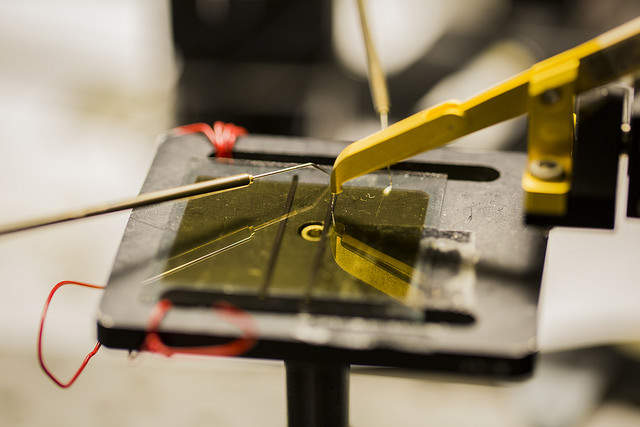
Organic solar cells are a step closer to widespread use thanks to a breakthrough in semiconductors by researchers at the University of Michigan.
A study published in Nature explains how it is possible to make electrons travel much further in organic solar cells than previously thought possible, improving their efficiency and opening up an array of potential applications.
Successful large-scale implementation of solar energy depends on three criteria: efficiency, life expectancy and cost. Organic solar cell materials – those made from carbon-based materials like plastic – are much cheaper than their inorganic, silicon-based counterparts.
However, organic solar cells lack the efficiency needed for commercial use compared with traditional silicon cells, requiring the surface of the cell to be covered with conductive electrodes to collect electrons at the point of generation.
The key to the breakthrough is that electrons can be collected far away from their point of origin, opening up a range of possibilities – such as photovoltaic windows.
“Think about making something that is completely transparent and yet is absorbing a substantial amount of light you don’t see,” said lead researcher Stephen Forrest, the Peter A. Franken Distinguished University Professor of Engineering. “What you need to do is clear out all of the things that are going to make it difficult to get light through.”
How well do you really know your competitors?
Access the most comprehensive Company Profiles on the market, powered by GlobalData. Save hours of research. Gain competitive edge.

Thank you!
Your download email will arrive shortly
Not ready to buy yet? Download a free sample
We are confident about the unique quality of our Company Profiles. However, we want you to make the most beneficial decision for your business, so we offer a free sample that you can download by submitting the below form
By GlobalDataThe researchers, supported by the US Department of Energy SunShot Initiative and by the US Air Force Office of Scientific Research, made the initial discovery almost by accident while experimenting with organic solar cell architecture.
Using a technique called vacuum thermal evaporation, they layered a thin film of C60 fullerenes on top of an organic cell’s power-producing zone, where the photons from sunlight knock electrons loose from their associated molecules. On top of the fullerenes they put another layer of fullerenes to prevent the electrons from escaping, forming what is known as an energy well.
“You can imagine an energy well as sort of a canyon—electrons fall into it and can’t get back out,” said Caleb Cobourn, a graduate researcher in the U-M Department of Physics and an author on the study. “So they continue to move freely in the fullerene layer instead of recombining in the power-producing layer, as they normally would. It’s like a massive antenna that can collect an electron charge from anywhere in the device.”
Because organic materials are built from a molecular level rather than atomic, they are far more malleable. When this improved efficiency is combined with pliability, the implications are far-reaching. An organic solar cell, for example, could be made 1,000 times thinner than those that are silicon-based, thereby offering huge savings on materials.
As well as cost reduction, the malleability means organic solar cells could be customised for a particular use in the market. Solar cells could be rolled out onto a car roof, created with different colour schemes such as military camouflage, or built into an invisible grid, for example.
The breakthrough isn’t just limited to solar power, with Forrest listing its use in anything from batteries to sensors. However, he cautioned that widespread use of the discovery remains theoretical at this point. “There are too many factors that go into determining these things. Our job is to present these findings and let the commercial chips fall where they may.”



